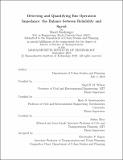Detecting and quantifying bus operation impedance : the balance between reliability and speed
Author(s)
Sindzingre, Maud.
Download1139524257-MIT.pdf (31.22Mb)
Other Contributors
Massachusetts Institute of Technology. Department of Urban Studies and Planning.
Advisor
Nigel H. M. Wilson, Haris N. Koutsopoulos, and Jinhua Zhao.
Terms of use
Metadata
Show full item recordAbstract
This thesis explores the phenomenon of bus impedance, defined as a slowing down of bus operations for customers. Impedance can stem from an overemphasis on reliability to the detriment of speed in bus operations. Public transport agencies aim at achieving the best balance between speed and reliability in their bus operations because such a balance benefits their customers who want to arrive at their destinations quickly and reliably, and potentially reduces the cost of operations. Impedance can result from misaligned interests of stakeholders, for instance if the agency provides financial incentives only for reliability. Impedance manifests itself through held and/or slow buses aimed at regulating the service but slowing it down as a consequence. A data-driven approach investigates the manifestations and the detection of impedance using the London bus network as a case study. Analyses include the assessment of the impact of changes in contract specification, the comparison between bus and Google API traffic speeds, and the use of holding announcements on the bus network. Taking the trip as the unit of analysis, the dwell, travel, and movement times of trips, among others, contribute to understanding the route behavior and detecting times with possible impedance. Models of the total dwell time per trip using the number of passengers and stops made per trip as explanatory variables are proposed, which can be used to estimate the dwell time theoretically needed based on the passenger activity. Building on these analyses, this thesis proposes two indicators to detect impedance at the trip-level in the form of holding. A decision-support tool intended for the bus operations management teams comprises (1) the correlation between the dwell time and the dwell time allowance and (2) the proportion of trips with a high value of the ratio of the actual dwell time to the theoretically needed dwell time for the trip. This tool is designed to extract information about route performance and could be used to supplement the expertise of the bus management teams in making scheduling and operational decisions.
Description
This electronic version was submitted by the student author. The certified thesis is available in the Institute Archives and Special Collections. Thesis: S.M. in Transportation, Massachusetts Institute of Technology, Department of Urban Studies and Planning, 2019 Cataloged from student-submitted PDF version of thesis. Includes bibliographical references (pages 171-173).
Date issued
2019Department
Massachusetts Institute of Technology. Department of Urban Studies and PlanningPublisher
Massachusetts Institute of Technology
Keywords
Urban Studies and Planning.